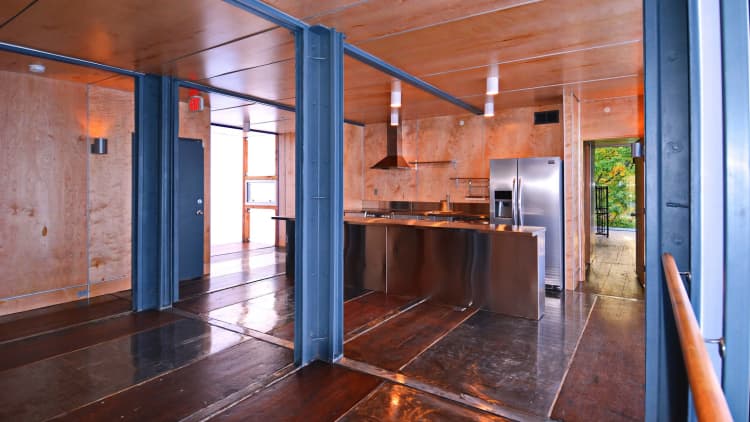
Every day, 21,000 of them sail into U.S. ports, carrying everything from tea to T-shirts, but just a fraction ever go back. Shipping containers. Strong, durable and eminently recyclable. An estimated 700,000 are sitting near the nation's waterfronts, unused, wasting shipyard space and littering landfills. It all presents an incredible opportunity for developers of environmentally friendly, sustainable real estate.
"The structural integrity of a shipping container is paramount. It's the starting point," said David Campbell, standing in a sea of containers in his Charlotte, North Carolina, factory. "It's a really great building platform. Take the raw form and transform it into something that's larger in scale."
Retail space, restaurants, multifamily apartment structures—the possibilities are still emerging daily. At Campbell's Boxman Studios, designers work on computers, virtually swinging the heavy containers every which way in an effort to find new ways to repurpose them.
Read MoreSan Francisco housing: Time for a correction?
"It is a Lego piece, so how do you put them together using different capacities," Campbell asked rhetorically.
Credit: Travis Price Architects
For him, it began with a few pictures of containers he saw online—and an idea to use them as pop-up marketing spaces for all kinds of venues: NASCAR races, concerts, sporting events. That brought his company attention from major brands like Hyundai, Under Armour, Nike and Google.
The container carcasses are not just strong and mobile, they are relatively cheap building materials, ranging anywhere from $800 to $3,000. Campbell buys them from ports, brokers and individual sellers. He has completed projects ranging from $10,000 to $2 million.
"We are the only in-house design and engineering company that has a full set of fabrication abilities—from heavy metal to ornate metal to custom cabinetry, and then we also run our own trucking company," Campbell said.
Read MoreHome prices headed for a triple dip
What's tricky are the regulations, because there aren't any on a national level. Developers have to work with each municipality, which could label the containers modular, mobile or permanent construction and then impose zoning and building codes depending on the decision.
"The real trick is going to be not to disguise it with some sort of phony traditionalism but to begin to embrace them and to see all the variations that can happen," said Travis Price of Travis Price Architects.
Price designed a multifamily apartment building in Washington, D.C., near the campus of Catholic University. It took just four months to turn 18 metal boxes into micro-unit apartments. Home sweet home for a group of college students.
Read MoreBen Bernanke, I feel your pain!
"At first I thought it was a little crazy, but when I saw it going up, I thought it was pretty cool," said Nick Pelli, a junior at Catholic, who rents an apartment with several other students in the container complex.
"A lot of people have been coming by, even the nun from the convent came by and blessed our unit the other day. There's a lot of buzz about it," said Henry Rasweiler, a senior and fellow container tenant.
The sheer strength and simplicity of the structures are an open palate for architects and engineers—and entrepreneurs like Boxman's Campbell, who thinks they would be ideal for disaster relief or the military. He said he gets calls every day from potential customers with new ideas—good news for the future of so much idle metal.


